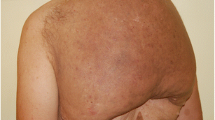Abstract
Background
Plexiform neurofibromas (PN) can determine pain, nerve function impairment, and, when extremely large, also deformity. Surgical is often partial, with possible recurrence, and the risk of malignant transformation.
Method
We describe the surgical strategy in a case of huge multiple plexiform neurofibromas of the left arm. We attempted to achieve a safe resection under the intraoperative guidance of fluorescein, with a dedicated microscope filter (YELLOW560). This technique can be also applied to other locations.
Conclusion
Fluorescein-guided surgery, coupled with intraoperative neurophysiological monitoring, increases the safe resection rate, considering the risks of neurological deficits and the possible malignant transformation.




Similar content being viewed by others
References
Cavallo C, De Laurentis C, Vetrano IG, Falco J, Broggi M, Schiariti M, Ferroli P, Acerbi F (2018) The utilization of fluorescein in brain tumor surgery: a systematic review. J Neurosurg Sci 62(6):690–703
Gutmann DH, Ferner RE, Listernick RH, Korf BR, Wolters PL, Johnson KJ (2017) Neurofibromatosis type 1. Nat Rev Dis Prim 3:17004
Hara T, Inami M, Hara T (1998) Efficacy and safety of fluorescein angiography with orally administered sodium fluorescein. Am J Ophthalmol 126(4):560–564
Kim DH, Murovic JA, Tiel RL, Moes G, Kline DG (2005) A series of 397 peripheral neural sheath tumors: 30-year experience at Louisiana State University Health Sciences Center. J Neurosurg 102(2):246–255
Riccardi VM (2007) The genetic predisposition to and histogenesis of neurofibromas and neurofibrosarcoma in neurofibromatosis type 1. Neurosurg Focus 22(6):E3
Russell SM (2007) Preserve the nerve: microsurgical resection of peripheral nerve sheath tumors. Neurosurgery 61(3 Suppl):113–117 discussion 117-8
Stone JJ, Spinner RJ (2019) Go for the gold: a “Plane” and simple technique for resecting benign peripheral nerve sheath tumors. Oper Neurosurg. https://doi.org/10.1093/ons/opz034
Tiel R, Kline D (2004) Peripheral nerve tumors: surgical principles, approaches, and techniques. Neurosurg Clin N Am 15(2):167–175
Vetrano IG, Bagatti D, Cordella R, Tramacere I, Nazzi V (2018) Intraoperative compound muscle action potentials (CMAPs) amplitude changes after decompression and neurolysis of peripheral nerves in upper limbs neuropathies: electrophysiologial considerations and relation with clinical outcome. J Neurosurg Sci. https://doi.org/10.23736/S0390-5616.18.04513-7
Vetrano IG, Lucarella F, Dalolio M, Di Cristofori A, Nataloni IF, Tiberio F, Gaini SM, Grimoldi N (2014) The importance of predicting factors in the surgical outcome of peripheral nerve sheath tumors. J Neurol Surg A Cent Eur Neurosurg 75(2):104–109
Author information
Authors and Affiliations
Corresponding author
Ethics declarations
Conflict of interest
The authors declare that they have no conflict of interest.
Informed consent
The patient and next of kin have consented to the submission of this “How I Do It” to the journal.
Ethical approval
All procedures performed were in accordance with the ethical standards of the institutional research committee and with the 1964 Helsinki declaration and its later amendments or comparable ethical standards.
Additional information
Key points
(1) Be sure that patients know the very low risks related to fluorescein injection.
(2) Correctly place the needles for EMG
(3) Strong collaboration with neurophysiologists for IOM to avoid irreversible nerve damages.
(4) Before the first YELLOW560 visualization, wait at least 30’ after fluorescein administration
(5) Recognize intact nerves before the piecemeal resection.
(6) Intraoperative ultrasounds and color Doppler can identify major vessels
(7) Neurofibromas, also the subcutaneous components, appear intensely fluorescent if compared with normal nerves
(8) The vessels show intermediate fluorescence, due to fluorescein intravascular diffusion.
(9) Following fluorescence, the resection rate can be greatly increased: its limits are established by IOM. The main goal is to avoid neurological impairment
(10) A close neuroradiological and clinical follow-up is necessary in case of large remnants
Publisher’s note
Springer Nature remains neutral with regard to jurisdictional claims in published maps and institutional affiliations.
This article is part of the Topical Collection on Peripheral Nerves
Electronic supplementary material
The video shows the different phases of the surgical procedures, from positioning and skin incision to the tumor removal. Preoperative MRI and intraoperative Doppler-US examination are depicted too. (MP4 253,977 kb)
Rights and permissions
About this article
Cite this article
Vetrano, I.G., Saletti, V. & Nazzi, V. Fluorescein-guided resection of plexiform neurofibromas: how I do it. Acta Neurochir 161, 2141–2145 (2019). https://doi.org/10.1007/s00701-019-04038-5
Received:
Accepted:
Published:
Issue Date:
DOI: https://doi.org/10.1007/s00701-019-04038-5




